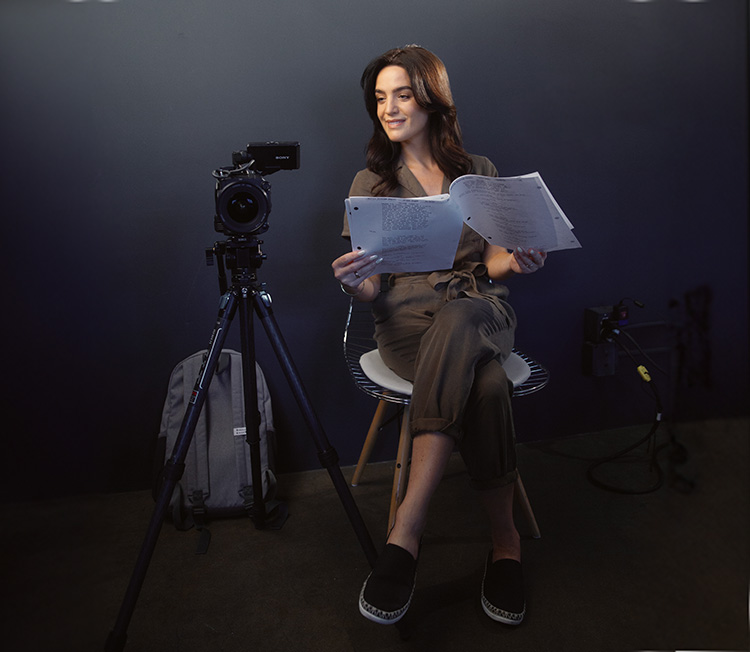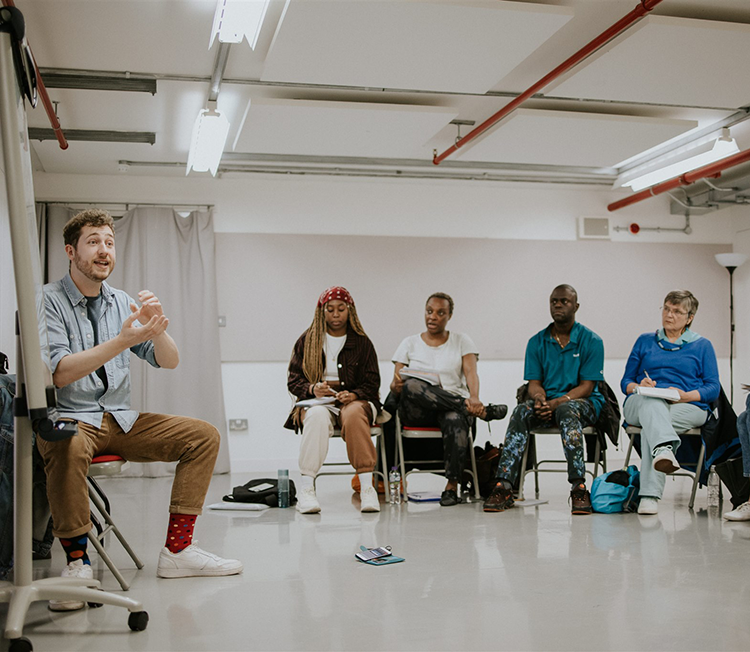How to navigate the world of performing when you don’t have an agent, and how to make the most of Spotlight as a self-represented actor
We’ve recently made some changes to Spotlight to make it easier for performers representing themselves to use the platform and self-submit for jobs. In this episode of the Spotlight Podcast, we’re joined by Spotlight’s Customer Success Manager, Mel Brown, to talk us through those changes and how to best use Spotlight if you don’t have an agent. self-represented performer on Spotlight.
 Mel has a wealth of knowledge about the industry and shares some of her career advice for actors including:
Mel has a wealth of knowledge about the industry and shares some of her career advice for actors including:
- * The changes made on Spotlight to make things better for self-represented performers.
- * How to navigate putting yourself forward for roles when you don’t have an agent.
- * How to make your Spotlight profile the best it can be.
- * Tips for headshots, showreels and voice reels.
38-minute listen.
There have been some changes to how self-represented performers use Spotlight – can you summarise what’s different?
‘Self-Represented’ used to be known as ‘Care of Spotlight’ so you would’ve seen ‘Care of Spotlight’ written on performers’ profiles. This has now changed to display ‘Self-Represented’ if that’s what you are.
If you’re sending your Spotlight profile link out to people or have it in your bio, email signature, social media, etc, then people viewing it will see two different things:
- If a casting professional isn’t signed into Spotlight, they’ll see the email address enquiries@spotlight.com on your profile, and will be able to contact that email address. We will forward those enquiries on to you – as long as they are professional enquiries.
- If a casting director is signed into Spotlight, they’ll be able to see that you’re self-represented, alongside a contact form so they can send you a message from their account.
Casting directors might get in contact with you via the form to do an availability check to see if you’re around for dates for a project they might be casting. They may be looking to ask you to do a self-tape, or they might just be asking you specific questions about skills that you have on your profile, or to see more of your showreel or audio work. Be sure to use the email address on Spotlight that you use regularly and that casting professionals can contact you! You can then respond directly to the casting director’s email and have a little dialogue there.
How do self-represented performers’ profiles appear in casting searches on Spotlight?
The main thing to know is that when casting professionals are viewing self-represented profiles, they’ll see ‘Self-Represented’ and then the contact form. That’s slightly different to how it was previously because everyone would email enquiries@spotlight.com, whereas now they can contact you directly.
Visually, what’s changed for casting directors is that they’ll be able to actually see how to contact you. It says, ‘Contact performer’, they click on that, and then it goes directly to a form they can fill out and send to you as an email. We’ve made it easier for casting directors to get in touch with you.
How do I go about searching for castings on Spotlight if I’m a self-represented performer?
If you are self-represented on Spotlight, you will see the jobs feed board, which has different ways that you can filter the jobs you see. In your account, if you go to ‘My tools and settings’, you can set certain filters, for example, gender, age range, height, etc. If you set your settings directly to what your casting type is, you would get quite specific job advertisements.
I recommend that if you’re self-represented, you need to really be checking the jobs feed board regularly because new jobs are added all the time. I would say don’t be attached to it, but check the jobs feed board at least once a day, and If there’s a role that’s right for you, put yourself forward for it. Do it sooner rather than later, just because you never know how many people are going to be suggested for a role. You’ll see lead time on the projects sometimes being maybe a week or two, but I would say don’t worry about that, just go straight into putting yourself forward as soon as possible.
How do I self-submit for roles?
You click on what we call the ‘breakdown’ – that’s basically the job brief. Look at it and read the notes, really focusing on the casting dates and filming dates or, if it’s a stage show, rehearsal dates and when it’s running to make sure that you’re available for all of those dates.
There’ll be a description of the character that hopefully suits you. Read it all, and then there’ll be a little bit at the bottom, where you’ll see the headshots that you currently have displayed on your profile. You can change your headshot to suit the role. If the role is looking for a happy, bubbly person, you might want to go for a smiley photo. If it’s more of a serial killer, you might want to pick your serious one. It really depends on the role and what the description is.
And then you’ll see a little box. Use this space to write key things as to why you’re right for that role. You don’t need to write a long essay as to why you’re right, you just need to pull out key facts. For example, the character speaks French, they’re a strong swimmer, they can juggle, and you can do those things, so emphasise those skills in the box to make sure that the casting directors are aware that those are your skill sets.
Say they want an Italian accent, you can say, “Strong Italian accent. Please see my audio reel.” So, you can lead them to your profile and say, “Please watch this,” or, “Look at that,” to give more evidence of that skill. But really, all you want to do is make sure that you are directly emphasising why you’re right for that role.
Then press the ‘Submit’ button! That goes directly to the casting director, and they can then look at the suggestion in more detail and either get in contact or decide that you’re not right for the role this time.
Do you have any more advice for navigating the jobs feed, for example, setting email alerts?
Yes. When you’re signed into your Spotlight account, you’ll see ‘My tools and settings’. If you go into that, you’ll see at the top there’s a section called ‘email alerts’. These email alerts are specifically for your job feed emails. If you click into that it will say, ‘change email alerts’ and it’s important to have this set up – I would suggest once a day – just so you can sign in towards the end of the day, have a look, see what’s on there and then put yourself forward for the role if you are suitable for it.
Another thing to say when you’re on your jobs feed page is that you can track things that you’ve suggested yourself for. When you suggest yourself for something, it’ll have a little tick and then there are filters as well where you can filter by what you’ve suggested yourself for. So, for example, if you get an audition, you can go back to the brief to read it again and check it all through. There are a lot of different filters, so make sure that you have a look through it all because there’s a lot of hidden detail within Spotlight.
You can also filter by when a project is going to close, which is quite handy.
When you’re looking in the ‘My tools and settings’, you’ll see there’s a tab which says where things are in terms of contract types. It’s important to look at that because at Spotlight we advocate for paid roles, and you’ll see all the Equity agreements and things like that underneath ‘paid’, but there are low paid roles. That doesn’t mean that we accept jobs that are ‘expenses only’ or have no fee – because we do not believe that actors should be working for free when it comes to acting work – but we do know that performers are at different stages of their career, and some people might be interested in seeing lower paid or profit-shared projects. If you don’t want to see those, you can untick them and they won’t appear in your feed.
When a self-represented performer puts themself forward for something, how do they see what jobs they’ve applied for?
There is a dropdown box next to the search bar called ‘show all roles’, and you’ll see an option in it called ‘show roles with suggestions’. If you filter by that, you’ll be able to see everything that you put yourself forward for as a self-represented performer.
If I’m self-represented and put myself forward for a role, what does the casting director then see on their side?
The casting director will see the headshot that you have suggested yourself with, the details you wrote in the little text box, and it will say self-represented. They’ll then be able to click on your profile to view more or to look at your showreel, audio clips, etc.
They can mark whether they would like to invite you for a self-tape or audition, or if it’s a no. They can also make shortlists, so if you’re not right for the role or project they’re currently casting, they may put you on a different list should a potential project be coming up that they think you might have a useful skill for. Casting directors do keep lists of performers, so make sure that you’ve got all your skills listed on your profile.
One thing to be aware of when you submit yourself for a role is that the casting director sees a smaller version of your headshot. It looks a bit like a thumbnail and isn’t as big as what you see on your Spotlight profile. That’s why we always recommend having what we call the ‘traditional’ headshot on your profile. That’s a head and shoulders photo, because the close-up angle means casting directors will be able to see you very clearly when you suggest yourself to them.
Also, it’s worth mentioning that in the text box, casting directors see about 10 or so words, and then it will say ‘see more’, so if you’ve written more (and people often do), they’ll be able to read the extra stuff that you’ve written by clicking that text link. Knowing this is key because you can then front-load the most important things that make you right for a role so they’re more likely to click. That’s also why you don’t want to be like, “Oh hello Fred, thank you so much for your opportunity,” because you’ve wasted your 10 words. It might sound a little bit strange, but writing, “Clean, driving licence, speak fluent French,” will immediately highlight your skills as a performer. That’s what agents will be doing – they’re highlighting the skills of their clients.
Is there action performers can take if they see something inappropriate in the jobs feed?
Definitely. At the bottom of each job, you’ll see a ‘report concern’ button. If there’s something that looks unusual or something written on the breakdown that isn’t adding up, then please press the button and you’ll be asked to fill out some information about why you’re flagging the job. That goes directly to my team and we can address the issue.
Also, if you’re contacted directly by a casting director via the contact form on your profile, there’s also a facility for you to report something to us if something doesn’t add up or look right.
Sometimes casting directors just accidentally miss things off or they haven’t explained things fully, and we can go back to them to get an amendment with further details. So it’s important to get in contact if you do think something is missing or not right, and we will look into it.
What are the most important things that self-represented performers should have on their Spotlight profile?
Look at your profile like you don’t know yourself because that’s essentially what the casting director will be doing. You want to make sure that your skills are highlighted and make sense.
Headshots
We recommend between around four to six headshots, and they should be your most current ones. Headshots are essential, so try and choose different expressions in the photos so that when you’re suggesting yourself for a role, you can choose between, for example, a serious one, a happy one, a sad one, or maybe a cheeky one.
Showreels
Media is also important. I think the word showreel does scare some people, but If you’re a professional actor, you’ll hopefully have a few credits and projects that you’ve done, so you can edit those into one lovely showreel that’s around three to five minutes long. We always recommend your strongest scene at the beginning.
The main thing a casting director wants to see and hear is what you look like on camera and your acting ability, so make sure that you’re speaking straight off the bat. You might have done some beautiful acting where not everything was described with words, but if we, as viewers, don’t know the context of that scene, then we’re not invested in it. So no montages and no emotive pieces right at the beginning.
If you don’t have any scenes to use in a showreel
You’ll hear different things from different people, but for me, if you’re quite new and still gaining experience, having some acting material on your profile is essential because casting directors want to see your acting ability. Even if you record a minute-long piece and pop it on there, that can really help a casting director to see what your strengths are and what you look and sound like on camera.
Audio clips
For the audio side, you might need voice reels, singing reels or audio clips to show that there’s an accent that you’re really good at. Make sure that you have audio clips that really showcase those skills to casting directors.
International actor showreels
For international performers, I recommend having a showreel in English and a showreel in your native language. If you can subtitle that showreel, that would be very beneficial. A lot of the casting directors using the site are English-speaking, but we do have European casting directors as well.
One thing to emphasise with all these points is that it’s about quality over quantity. If you’re not happy with it, don’t put it on there. One scene in a showreel that is incredibly strong is so much more beneficial than four mediocre scenes.
What is the main difference between a Spotlight profile where the performer is managed by an agent versus one that is self-represented?
Everything is the same apart from you being the one putting yourself forward for the roles.
With the jobs feed board, casting directors can choose to send a project to both the agents and performers, and that means that you’ll be seeing that side of things. To be transparent, there will be projects that are only sent to agents, and that is the benefit of having an agent – sometimes they’ll see slightly different projects to what you see as a self-represented performer. But in terms of the profile and how it all works, it’s exactly the same as another performer who is represented. So nothing changes in that.
If a self-represented performer gets an agent, can they still put themselves forward for roles?
When you add an agent on Spotlight, your jobs feed board will go to view-only. You’ll not be able to suggest yourself for projects anymore but if you still want to be able to suggest yourself because you’ve agreed with your new agent that they’re, for example, only going to put you forward for commercials, but you’re going to do everything else, then you’ll need to contact that agent and ask them to set you back to ‘full access’. This can only be done by agents on their side – we can’t do this at Spotlight. Agents are aware of this and if for any reason they’re not, they can email us agents@spotlight.com.
If you have an agent, most of the time you’ll be set to view-only purely because if you had access to submit yourself as well, you’d potentially be doubling up on suggestions and appearing twice for casting directors, which causes a lot more work. The agent’s job is to get you work and put you forward for things.
If you would like a middle ground, there’s another option which is ’nudge’. So ’nudge’ is set by your agent, and it’s a little alert that gets sent to the agent when you’ve seen a job in the feed where you’ve gone, “Oh, I’m quite interested in this, will you put me forward for it?”
When you have an agent, you can ask to see what you’re being submitted for. We don’t recommend that you do this every week or every month, but if you’ve been with them for a year, you can maybe catch up with them and see a list of what they’ve been putting you forward for work-wise.
Are there any other self-represented performer tips you’d like to share?
When you’re self-represented, it’s important to assume the role of agent and make sure you’re suggesting yourself and getting back to any correspondence. Regular contact and checking of the jobs feed board is so important.
Equity is the performers’ union here in the UK. Being part of a union can be helpful because if there are things in your contract that aren’t upheld for some reason, or there are late payments, they can help with that side of things. Research the union so that you are aware of why joining could be a helpful thing.
There is a page on Spotlight that is a helpful resource for Spotlight agents and casting members that has lots of detail around agreements, contracts, codes of conduct, guidelines on nudity and intimacy, etc. If you’re self-represented, being aware of all those things is essential.
There’s a wealth of knowledge in Spotlight’s news and advice section where you can have a look at different things and also our frequently asked questions section. There’s an FAQ specifically for self-represented performers.
Useful Resources for Self-Represented Performers
- You can find contract information on our Agent and Casting members resources page
- We answer your questions about being self-represented on Spotlight
- Tips for working without an agent
- Tips to make your Spotlight profile the best it can be
- Get in touch by using Spotlight’s help centre
Photo credit: blackCAT / iStock
Headshot credit: Robin Savage











